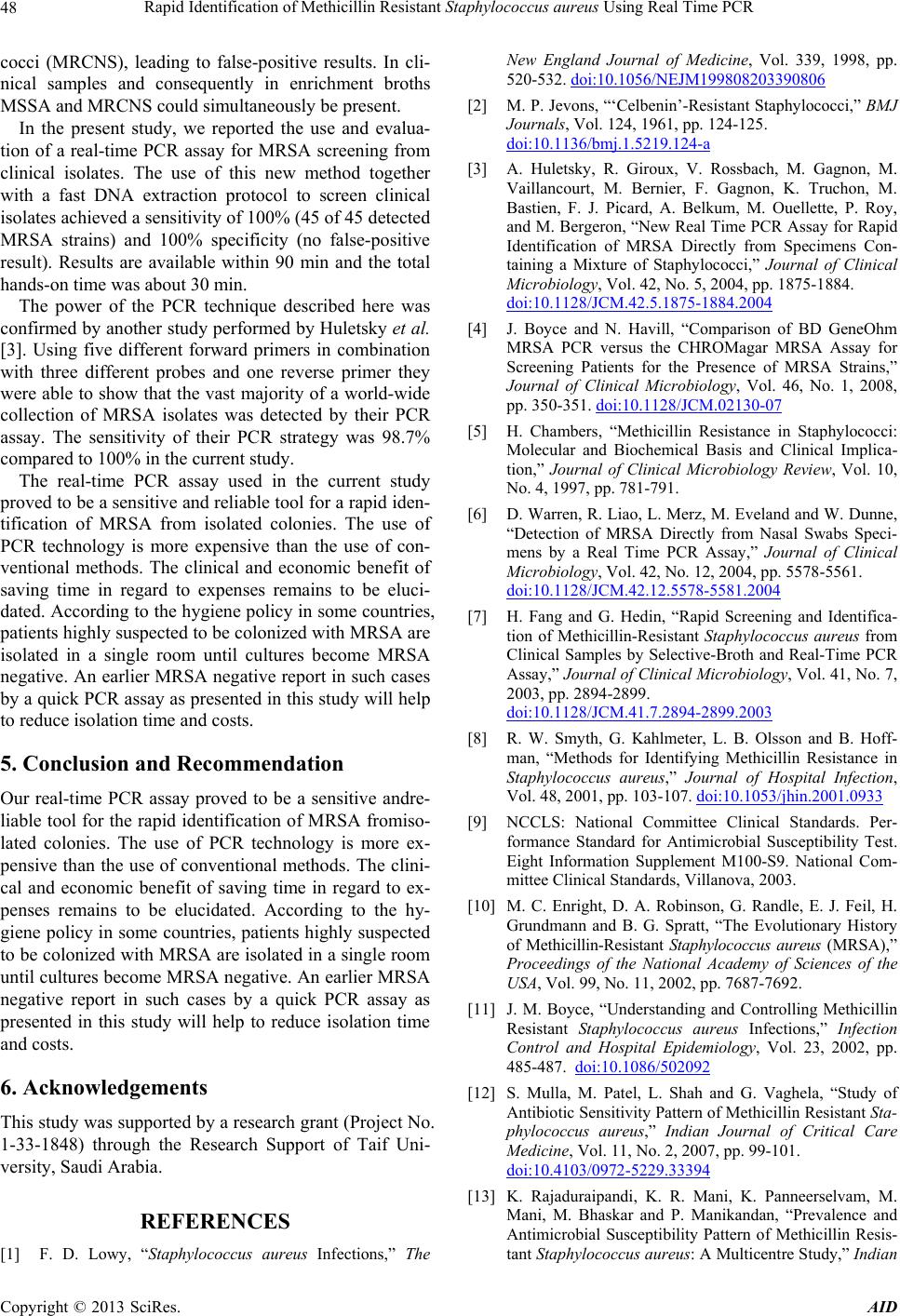
Rapid Identification of Methicillin Resistant Staphylococcus aureus Using Real Time PCR
48
cocci (MRCNS), leading to false-positive results. In cli-
nical samples and consequently in enrichment broths
MSSA and MRCNS could simultaneously be present.
In the present study, we reported the use and evalua-
tion of a real-time PCR assay for MRSA screening from
clinical isolates. The use of this new method together
with a fast DNA extraction protocol to screen clinical
isolates achieved a sensitivity of 100% (45 of 45 detected
MRSA strains) and 100% specificity (no false-positive
result). Results are available within 90 min and the total
hands-on time was about 30 min.
The power of the PCR technique described here was
confirmed by another study performed by Huletsky et al.
[3]. Using five different forward primers in combination
with three different probes and one reverse primer they
were able to show that the vast majority of a world-wide
collection of MRSA isolates was detected by their PCR
assay. The sensitivity of their PCR strategy was 98.7%
compared to 100% in the current study.
The real-time PCR assay used in the current study
proved to be a sensitive and reliable tool for a rapid iden-
tification of MRSA from isolated colonies. The use of
PCR technology is more expensive than the use of con-
ventional methods. The clinical and economic benefit of
saving time in regard to expenses remains to be eluci-
dated. According to the hygiene policy in some countries,
patients highly suspected to be colonized with MRSA are
isolated in a single room until cultures become MRSA
negative. An earlier MRSA negative report in such cases
by a quick PCR assay as presented in this study will help
to reduce isolation time and costs.
5. Conclusion and Recommendation
Our real-time PCR assay proved to be a sensitive andre-
liable tool for the rapid identification of MRSA fromiso-
lated colonies. The use of PCR technology is more ex-
pensive than the use of conventional methods. The clini-
cal and economic benefit of saving time in regard to ex-
penses remains to be elucidated. According to the hy-
giene policy in some countries, patients highly suspected
to be colonized with MRSA are isolated in a single room
until cultures become MRSA negative. An earlier MRSA
negative report in such cases by a quick PCR assay as
presented in this study will help to reduce isolation time
and costs.
6. Acknowledgements
This study was supported by a research grant (Project No.
1-33-1848) through the Research Support of Taif Uni-
versity, Saudi Arabia.
REFERENCES
[1] F. D. Lowy, “Staphylococcus aureus Infections,” The
New England Journal of Medicine, Vol. 339, 1998, pp.
520-532. doi:10.1056/NEJM199808203390806
[2] M. P. Jevons, “‘Celbenin’-Resistant Staphylococci,” BMJ
Journals, Vol. 124, 1961, pp. 124-125.
doi:10.1136/bmj.1.5219.124-a
[3] A. Huletsky, R. Giroux, V. Rossbach, M. Gagnon, M.
Vaillancourt, M. Bernier, F. Gagnon, K. Truchon, M.
Bastien, F. J. Picard, A. Belkum, M. Ouellette, P. Roy,
and M. Bergeron, “New Real Time PCR Assay for Rapid
Identification of MRSA Directly from Specimens Con-
taining a Mixture of Staphylococci,” Journal of Clinical
Microbiology, Vol. 42, No. 5, 2004, pp. 1875-1884.
doi:10.1128/JCM.42.5.1875-1884.2004
[4] J. Boyce and N. Havill, “Comparison of BD GeneOhm
MRSA PCR versus the CHROMagar MRSA Assay for
Screening Patients for the Presence of MRSA Strains,”
Journal of Clinical Microbiology, Vol. 46, No. 1, 2008,
pp. 350-351. doi:10.1128/JCM.02130-07
[5] H. Chambers, “Methicillin Resistance in Staphylococci:
Molecular and Biochemical Basis and Clinical Implica-
tion,” Journal of Clinical Microbiology Review, Vol. 10,
No. 4, 1997, pp. 781-791.
[6] D. Warren, R. Liao, L. Merz, M. Eveland and W. Dunne,
“Detection of MRSA Directly from Nasal Swabs Speci-
mens by a Real Time PCR Assay,” Journal of Clinical
Microbiology, Vol. 42, No. 12, 2004, pp. 5578-5561.
doi:10.1128/JCM.42.12.5578-5581.2004
[7] H. Fang and G. Hedin, “Rapid Screening and Identifica-
tion of Methicillin-Resistant Staphylococcus aureus from
Clinical Samples by Selective-Broth and Real-Time PCR
Assay,” Journal of Clinical Microbiology, Vol. 41, No. 7,
2003, pp. 2894-2899.
doi:10.1128/JCM.41.7.2894-2899.2003
[8] R. W. Smyth, G. Kahlmeter, L. B. Olsson and B. Hoff-
man, “Methods for Identifying Methicillin Resistance in
Staphylococcus aureus,” Journal of Hospital Infection,
Vol. 48, 2001, pp. 103-107. doi:10.1053/jhin.2001.0933
[9] NCCLS: National Committee Clinical Standards. Per-
formance Standard for Antimicrobial Susceptibility Test.
Eight Information Supplement M100-S9. National Com-
mittee Clinical Standards, Villanova, 2003.
[10] M. C. Enright, D. A. Robinson, G. Randle, E. J. Feil, H.
Grundmann and B. G. Spratt, “The Evolutionary History
of Methicillin-Resistant Staphylococcus aureus (MRSA),”
Proceedings of the National Academy of Sciences of the
USA, Vol. 99, No. 11, 2002, pp. 7687-7692.
[11] J. M. Boyce, “Understanding and Controlling Methicillin
Resistant Staphylococcus aureus Infections,” Infection
Control and Hospital Epidemiology, Vol. 23, 2002, pp.
485-487. doi:10.1086/502092
[12] S. Mulla, M. Patel, L. Shah and G. Vaghela, “Study of
Antibiotic Sensitivity Pattern of Methicillin Resistant Sta-
phylococcus aureus,” Indian Journal of Critical Care
Medicine, Vol. 11, No. 2, 2007, pp. 99-101.
doi:10.4103/0972-5229.33394
[13] K. Rajaduraipandi, K. R. Mani, K. Panneerselvam, M.
Mani, M. Bhaskar and P. Manikandan, “Prevalence and
Antimicrobial Susceptibility Pattern of Methicillin Resis-
tant Staphylococcus aureus: A Multicentre Study,” Indian
Copyright © 2013 SciRes. AID